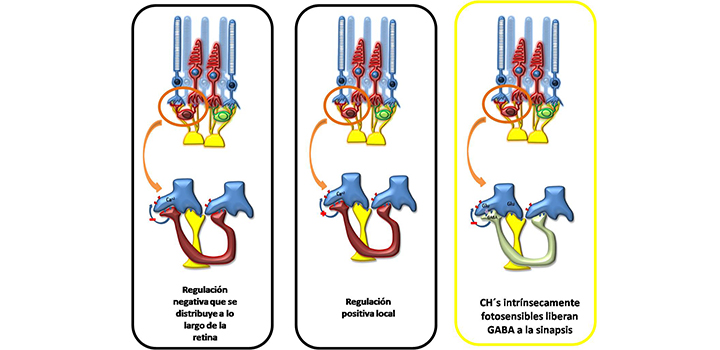Mulberry LP et al. 2016, Proc. Natl. Acad. Sci. USA
In the vertebrate retina, three types of photoreceptors-visual photoreceptor cones and rods and the intrinsically photosensitive retinal ganglion cells (ipRGCs)-converged through evolution to detect light and regulate image- and nonimage-forming activities such as photic entrainment of circadian rhythms, pupillary light reflexes, etc. ipRGCs express the nonvisual photopigment melanopsin (OPN4), encoded by two genes: the Xenopus (Opn4x) and mammalian (Opn4m) orthologs. In the chicken retina, both OPN4 proteins are found in ipRGCs, and Opn4x is also present in retinal horizontal cells (HCs), which connect with visual photoreceptors. Here we investigate the intrinsic photosensitivity and functioning of HCs from primary cultures of embryonic retinas at day 15 by using calcium fluorescent fluo4 imaging, pharmacological inhibitory treatments, and Opn4x knockdown. Results show that HCs are avianphotoreceptors with a retinal-based OPN4X photopigment conferring intrinsic photosensitivity. Light responses in HCs appear to be driven through an ancient type of phototransduction cascade similar to that in rhabdomeric photoreceptors involving a G-protein q, the activation of phospholipase C, calcium mobilization, and the release of the inhibitory neurotransmitter GABA. Based on their intrinsic photosensitivity, HCs may have a key dual function in the retina of vertebrates, potentially regulating nonvisual tasks together with their sister cells, ipRGCs, and with visual photoreceptors, modulating lateral interactions and retinal processing.
Authors: Morera LP, Díaz NM, Guido ME.
Article: Mulberry LP et al, Proc. Natl. Acad. Sci. USA. 2016 Nov 15;113(46):13215-13220



